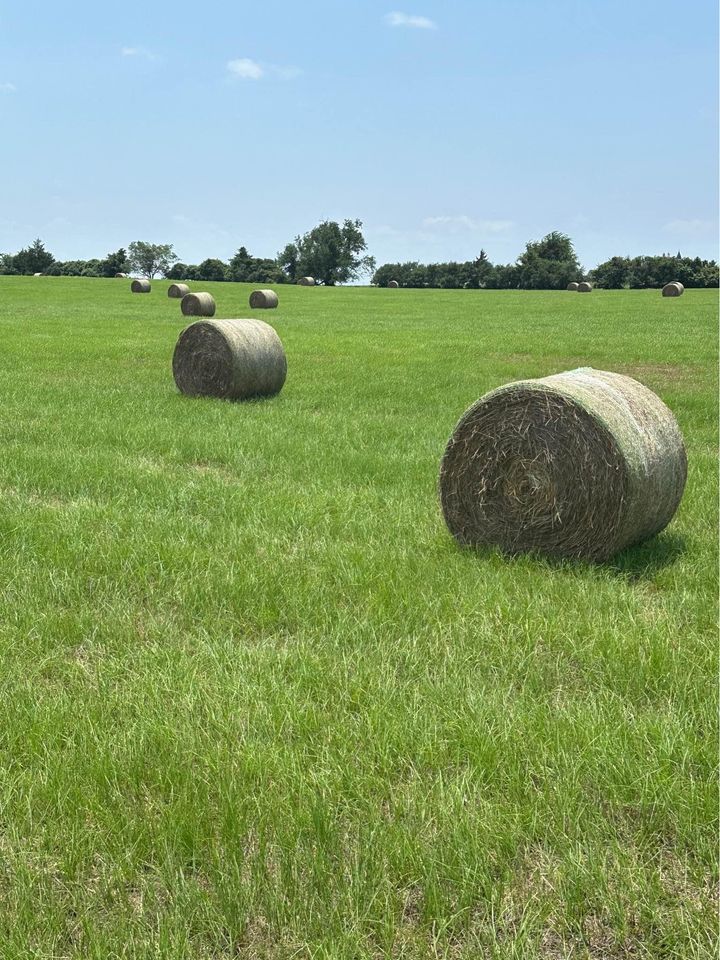At Black Wolf Ranch, we understand that effective hay management is essential for maintaining the health of your livestock and optimizing your operations. Given Texas’s unique climate and seasonal variations, proper hay management can make a significant difference in your ranch’s productivity. Here’s a tailored guide to seasonal hay management to help you keep your hay in prime condition throughout the year.
Spring: Preparing for the Year Ahead
As temperatures warm up, spring is the perfect time to evaluate your hay supplies and make necessary adjustments:
- Inspect Storage Areas: Before the new hay season begins, check your hay storage facilities for any signs of wear or damage. Ensure that the area is dry and well-ventilated to prevent mold and spoilage. Learn more about proper hay storage techniques.
- Evaluate Inventory: Take stock of your remaining hay from the previous season. This is the time to assess its quality and determine if any of it needs to be used up or replaced. Texas A&M AgriLife has resources for hay quality evaluation.
- Plan Your Harvest: With spring rains and growth, it’s a good time to plan your hay cutting schedules. Consider the timing of your first cutting to optimize the nutritional value of your hay. Explore tips on hay cutting and harvest management.
Summer: Managing Freshly Cut Hay
Summer is the peak haying season in Texas, and effective management during this time can significantly impact the quality of your hay:
- Monitor Weather Conditions: Weather plays a crucial role in hay production. Ensure you’re harvesting during dry periods to prevent moisture-related issues. Regularly check weather forecasts to avoid cutting before rain. Check local weather forecasts.
- Proper Curing: Allow hay to dry thoroughly before baling. Insufficiently dried hay can lead to mold and reduced nutritional value. Proper curing also helps in minimizing spoilage during storage. The University of Kentucky offers a guide on hay curing.
- Safe Baling: Bales should be firm and free from excessive moisture. Use quality balers and avoid overloading to ensure uniform bale density and minimize the risk of spoilage. Learn about baler maintenance and best practices.
Fall: Storing and Preserving Hay
As temperatures drop, fall is the time to focus on the storage and preservation of your hay:
- Optimize Storage Conditions: Ensure your storage facilities are well-protected from the elements. Proper ventilation and a dry, elevated surface can help prevent moisture buildup and mold growth. Find storage solutions and best practices.
- Monitor for Pests: Check regularly for signs of pests or rodents. Implement control measures to protect your hay from infestations. The USDA provides tips on pest management.
- Evaluate Hay Quality: Test your hay for nutritional content and adjust your feed plan if needed. Fall is a good time to start transitioning livestock to the winter feed program. Check out the importance of hay testing.
Winter: Protecting Your Hay Supply
Winter can be harsh, but with the right strategies, you can protect your hay supply and ensure its availability:
- Regular Inspections: Periodically inspect your stored hay to ensure it remains in good condition. Look for signs of dampness or mold and address issues promptly. Tips for winter hay storage.
- Efficient Use: Plan your hay usage to minimize waste. Proper feeding practices, such as using feeders to reduce waste and spoilage, can help stretch your hay supply. Learn about efficient feeding practices.
- Plan for Spring: Use winter downtime to plan for the next hay season. Evaluate what worked well and what could be improved in your hay management practices. Consider these spring planning tips.
Effective hay management is a cornerstone of successful ranching in Texas. By following these seasonal tips, you can maintain the quality of your hay, optimize your feed resources, and ensure your livestock are well-fed throughout the year.
Effective hay management is vital for successful ranching, and at Black Wolf Ranch, we’re committed to helping you navigate the complexities of Texas’s climate. Implement these seasonal tips to enhance your hay quality and optimize your feed resources. For more expert advice and ranching resources, don’t hesitate to contact us or subscribe to our blog.
Stay ahead of the game, keep your hay in top shape, and ensure a prosperous year for your ranch. Happy ranching!




